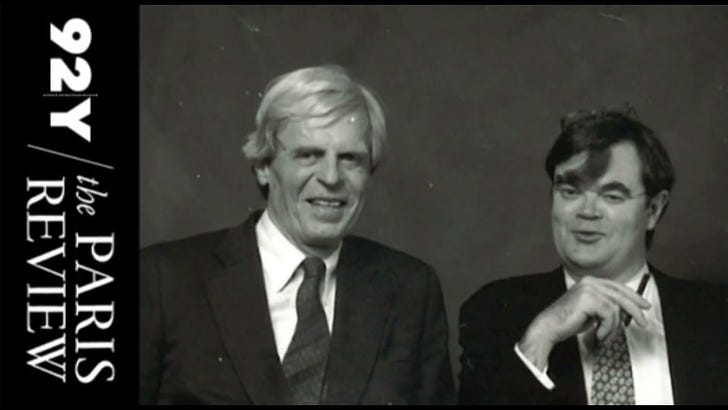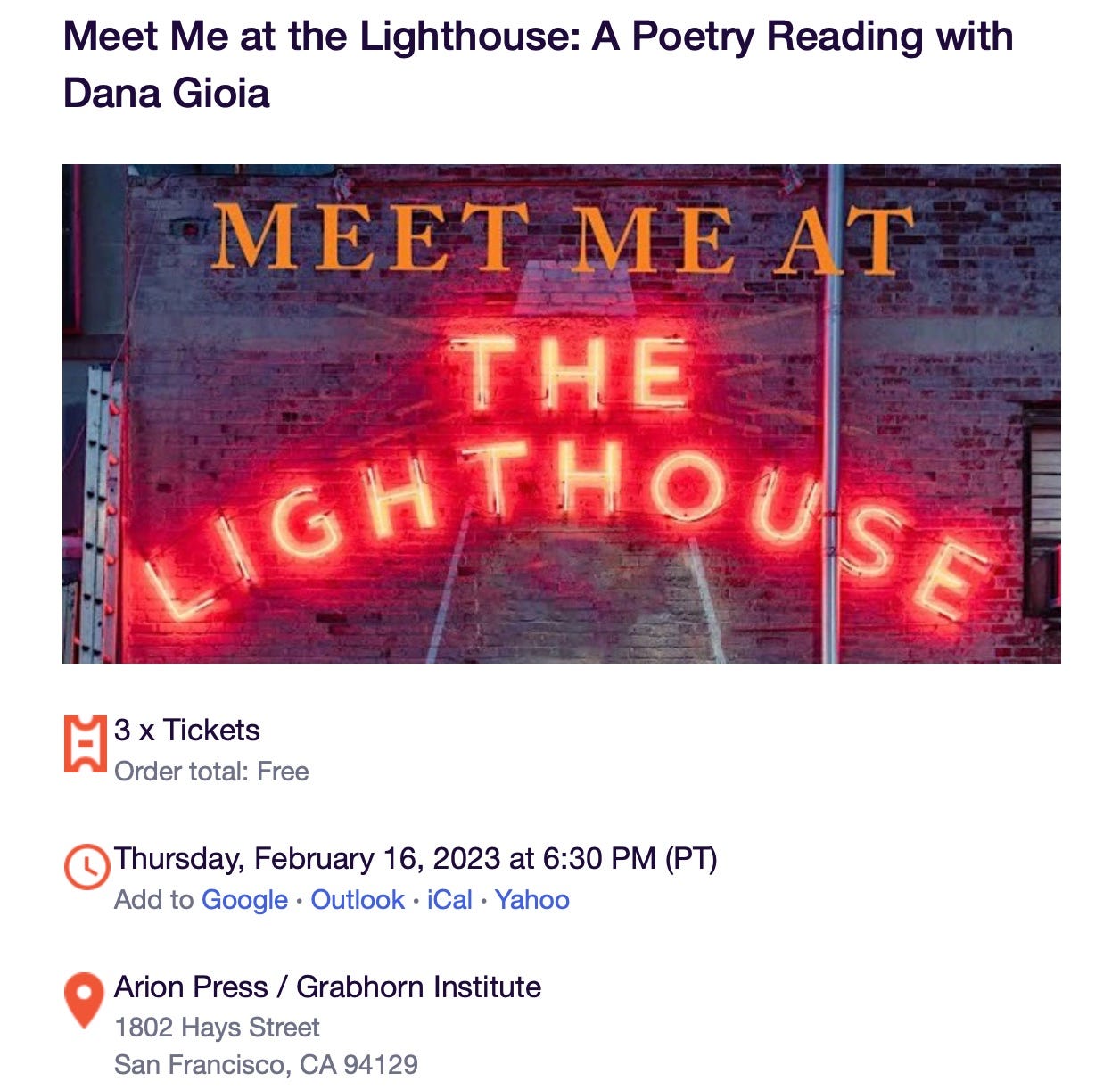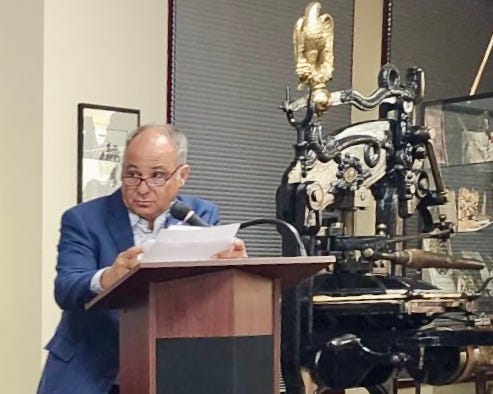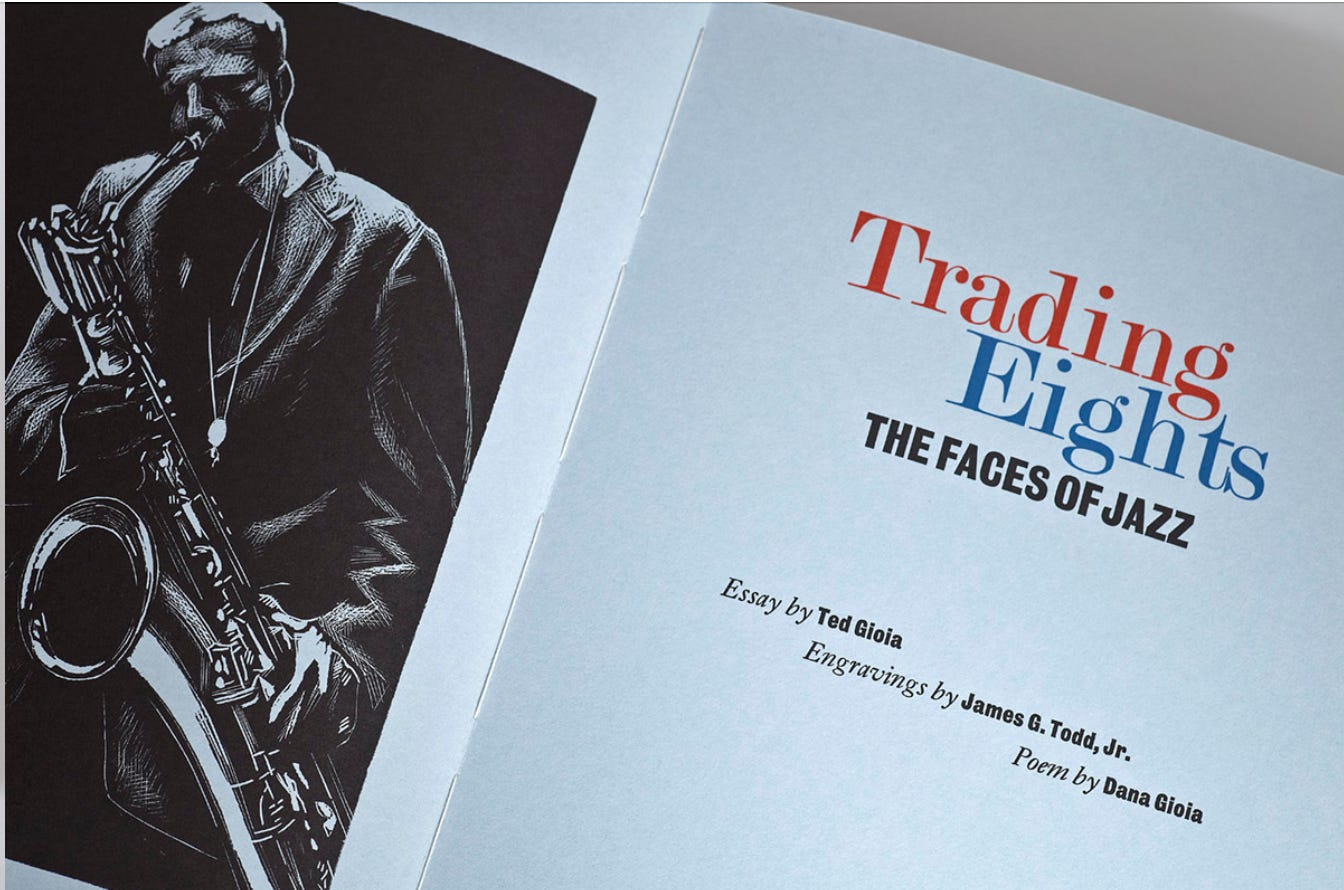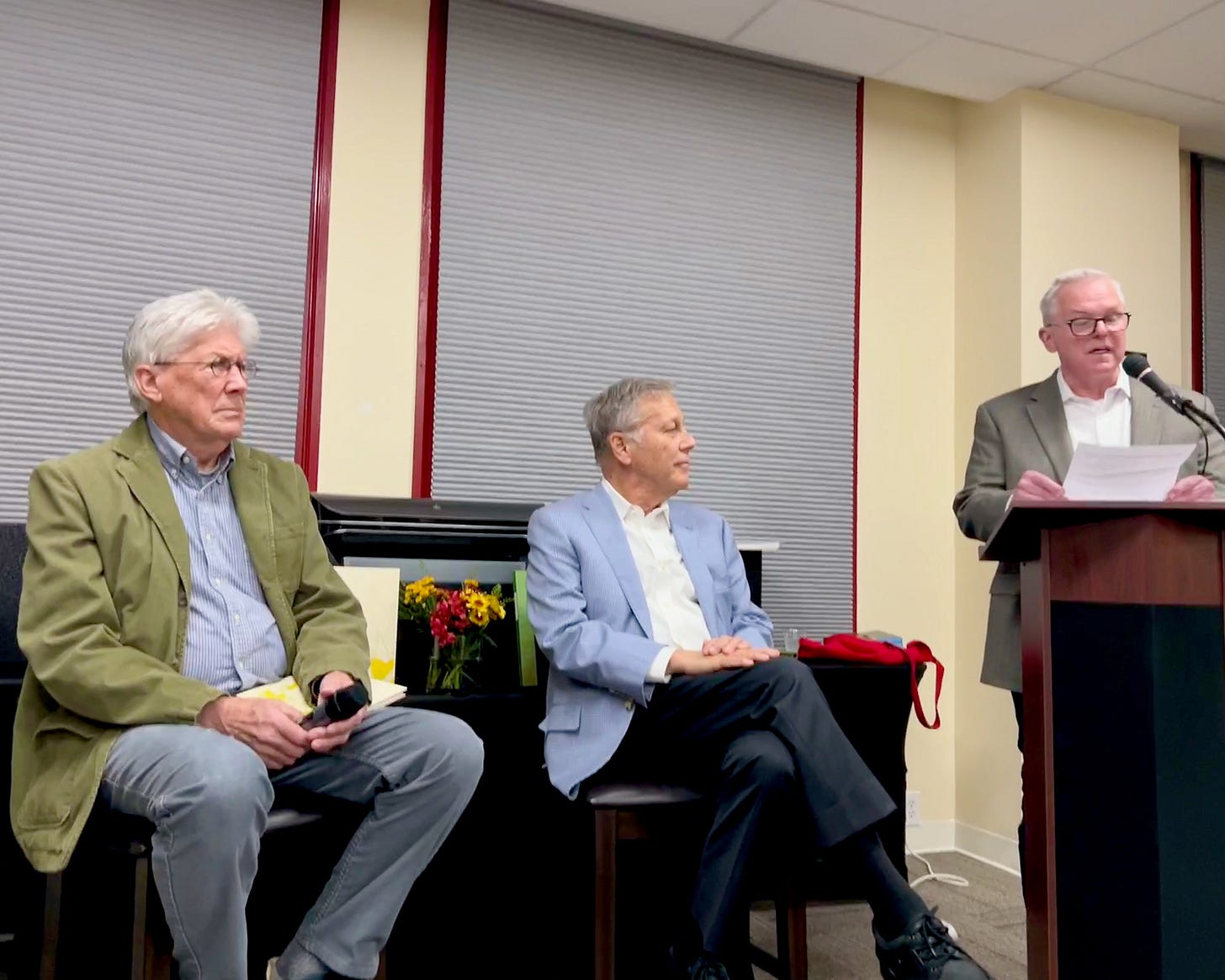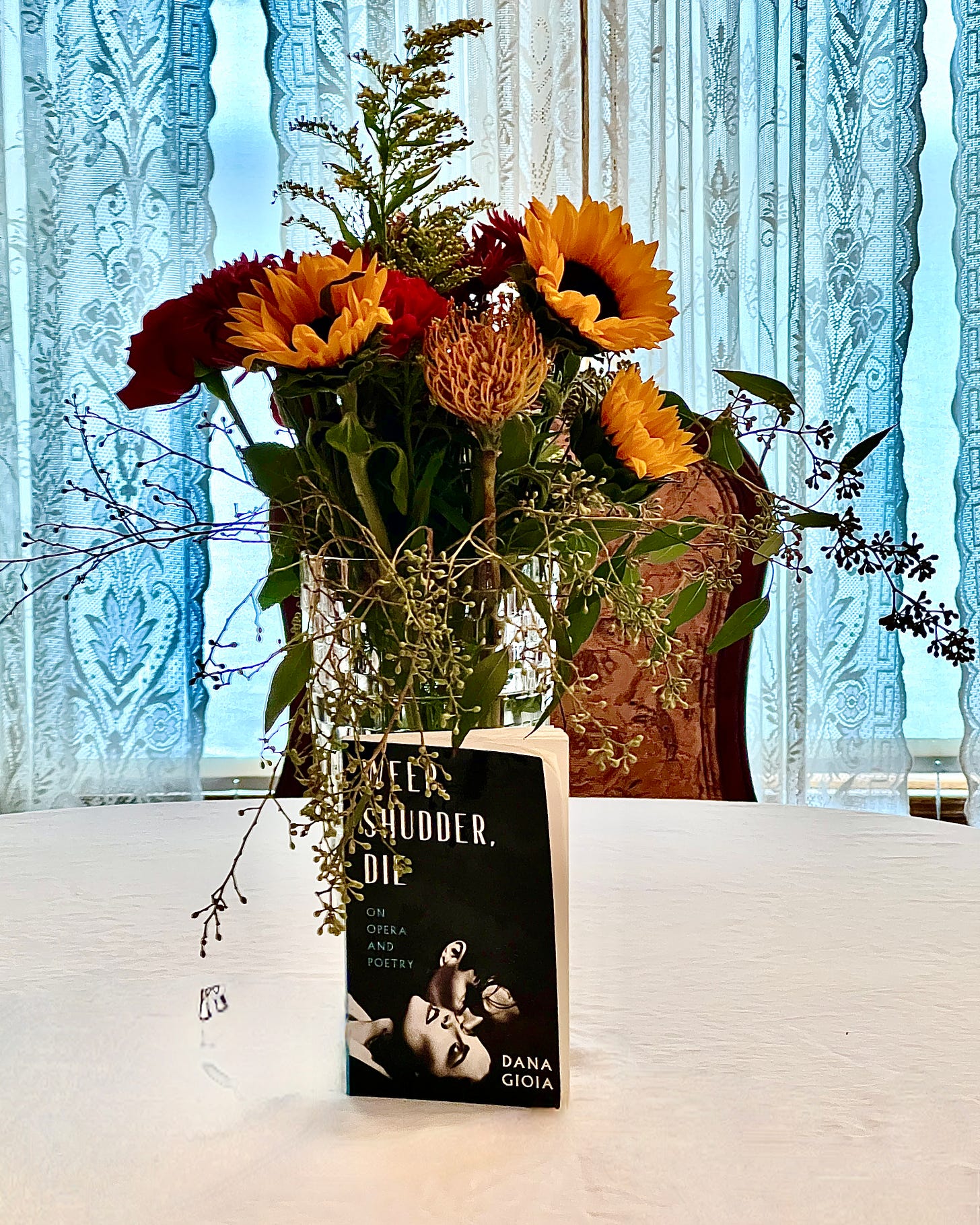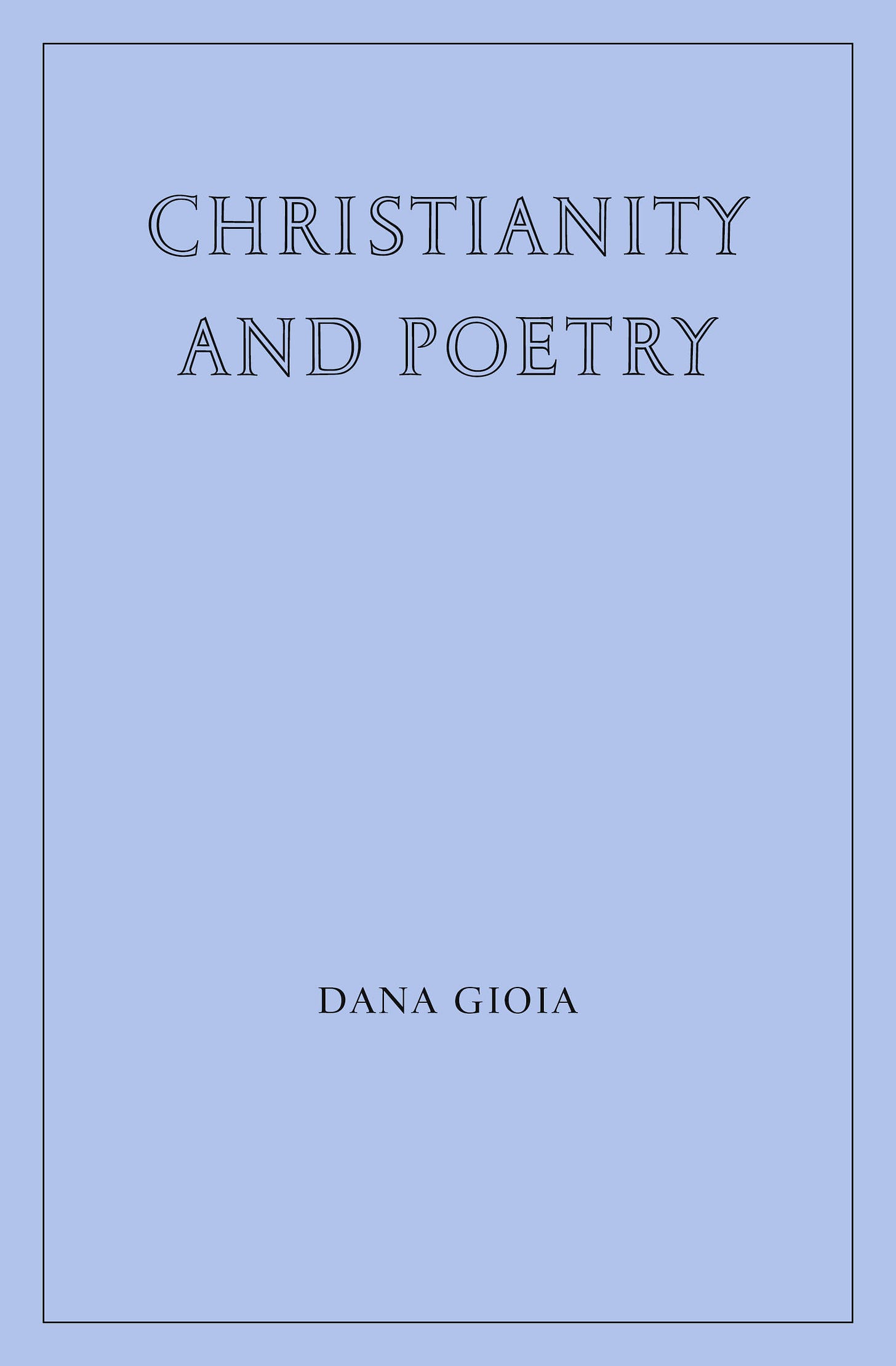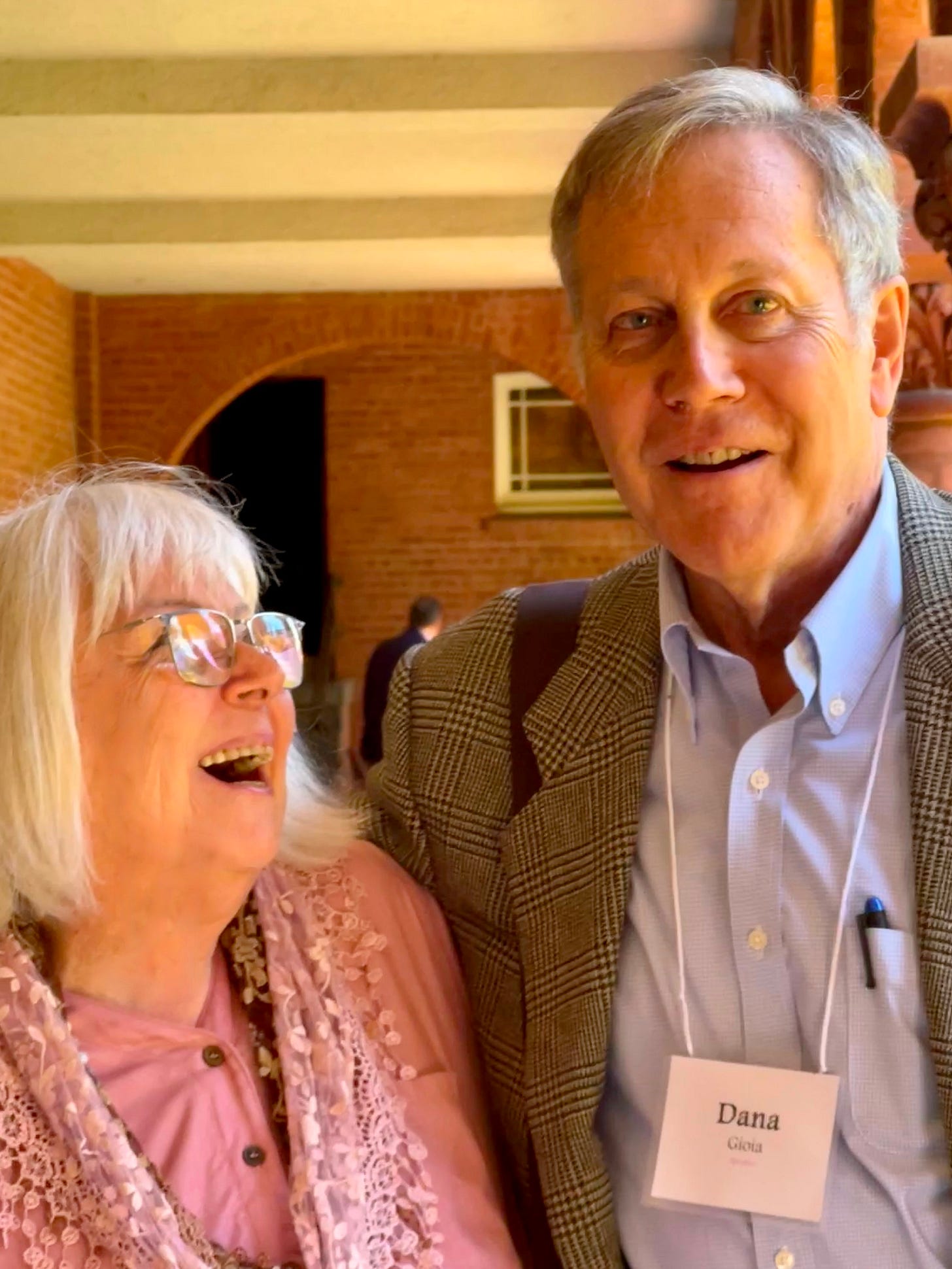December 24, 2024: Happy Birthday Dana Gioia
Dana Gioia continues to produce fine work as he begins his 75th year on earth
Dana Gioia, who many know as a distinguished poet, provocative critic, cultural observer, and Catholic, was born 74 years ago on Christmas Eve in 1950.
I should have realized that Dana Gioia, like most writers, monitors where his work is mentioned before I sent him an email on December 14. In it, I told him something he already knew, that two of his books were mentioned glowingly by four different Catholic World Report contributors and editors in "The Best Books I Read in 2024." Meet Me at the Lighthouse, (his latest book of poetry, which was published in February 2023) was mentioned three times (by Mary Jo Anderson, Conor B. Dugan, and Rhonda Ortiz), and Poetry as Enchantment, his recently released book of essays, was mentioned once (by CWR editor, Carl E. Olson).
I was honored that he had previously sent me copies of both of these books, and I was happy for him that others—of more renown than I—read and thought so well of them.
SCROLL DOWN FOR MORE
In his email reply to me about the CWR article, Dana told me he had seen that nice mention, and that he’d also gotten a small award: Micah Mattix at World Magazine had chosen Poetry as Enchantment as the 2024 Book of the Year in the Arts and Culture category.
From Facebook Roseanne Sullivan, November 12:
Amazon just notified me Dana Gioia's book of essays titled Poetry as Enchantment officially released today. I've had a copy for a while. I’m greatly enjoying the essays. You might want to check it out. Dana Gioia is a terrific essayist and the bits of memoir he weaves in are always interesting and thought-provoking. I've already written on my Substack about his review of Garrison Keillor's Good Poems here:
Many of his essays champion poets who aren't well known or whose work is out of favor. Donald Davie, who Dana studied under serendipitously—in the only poetry workshop he ever took, while he was working on his MBA at Stanford (part of his life plan to be a poet who was able to make a living outside of academia)—is now mostly unknown but had an estimable reputation, and the essay that features Davie is a revelation. Many more similarly fine essays are found in this volume.
Since this might be helpful for someone who hasn't heard of Dana's work, I'll quote from Mattix’s article, which begins with a short bio, and gives a summary of some of his points about what makes poetry important and what makes Dana’s book important:
A former executive at General Foods who went on to serve as chairman of the National Endowment for the Arts and poet laureate of California, Gioia sparked a national debate with his 1991 essay “Can Poetry Matter?” in which he considered the declining influence of verse. . . . Gioia has published six volumes of poetry and six collections of essays. In his latest collection of essays, Poetry as Enchantment (Paul Dry Books, 272 pp.), he continues his lifelong investigation into what makes poetry worth reading. . . .
"In the book, Gioia calls poetry “a special form of language that invites and rewards sustained attention,” but the prose of Poetry as Enchantment is also deeply rewarding. It is charming and rigorous, personal and profound—making it one of the best collections of essays in years." —Micah Mattix in "Love of poetry examined in World Magazine's 2024 BOOKS OF THE YEAR—ARTS & CULTURE | Dana Gioia invites readers into his poetic vision." You can and should read the whole thing here.
More About the Meet Me at the Lighthouse Book Launch
In 2023, I attended a Book Launch party for one of the books mentioned at CWR: Meet Me at the Lighthouse, Dana’s latest collection of poetry. The party was held at Arion Press. then located in San Francisco's former Presidio. Dana’s son, Ted, is Director of Events and Programs at Arion, and he introduced his father that night.
One good review of the book is here:
Around that time, Dana emailed links to two videos produced by his other son, Mike. This one is of Dana reciting the title poem from the book.
I’ll let Dana’s words introduce this next video “Psalm of the Heights,” about another poem from Meet Me at the Lighthouse: “I think it's the best film we have ever made—at least partially because my old mug doesn't appear on the screen. The other reason is that this is the poem I've wanted to write about LA for most of my life.” I found it thrilling and moving, the way the poem was recited in Dana’s dramatic baritone voice against the swirling background of LA traffic.
Book Launch for From California, a Collaboration
On November 12 of this year. I attended another Book Launch party for another book, From California: Poems by Dana Gioia, Engravings by Richard Wagener. The party was held at the headquarter of the Book Club of California, which is in a suite of offices in downtown San Francisco.
I first thought that the images would be illustrations of a selection of Dana's previously published poems about California, but Dana clarified that Wagener's engravings "do not illustrate individual poems." I also found out at the launch that only a selection of his California poems was used, for space reasons. When I interviewed Richard Wagener via Zoom before the launch, he told me more about the development of the idea for the fine press book and explained the hand-crafted way it was printed.
Richard Wagener Interview
RTS: This book is described as two artists in different media representing California. Could you tell me how this book came into being?
RW: I don't know the whole story of it, but Gregory Krisilas, who's associated with the Book Club of California, one of Dana’s friends, came to me and said he had been talking to Dana about the possibility of doing a book for the Book Club with Dana's poems and wanted me to be involved with it. So that was my introduction to this as a project itself.
However, some years back, maybe seven years ago now, I was up at Dana's house in Santa Rosa talking to him about a different project where his brother wrote an essay for a book that I was doing. And the thought was, well, wouldn't it be nice to have both brothers represented in the book? So I said, Dana, how would you like to write a poem for it? And he said, well, he'd think about it.
RTS: What was the book?
RW: Trading Eights: The Faces of Jazz. It featured wood engraved portraits of some of the jazz icons that were done by James Todd, a fellow engraver who lives in Montana. I just really admired his work. So with a collaborator of mine, it started when we decided to do a book featuring those jazz portraits.
RW: Dana's brother Ted is a jazz critic and writer. [RTS: Ted’s Substack is The Honest Broker here.] So I contacted him, and he said, okay. And then I talked to Dana and said, “Well, your brother's writing for us.” Dana didn’t agree right away.
Then one night I received an email from Dana and he said, “I've got it. I know what I'll do, so I'll give you a poem.” It was Meet Me at The Lighthouse.
RTS; Oh wow. That’s the name of his last poetry collection. I was at the Book Launch for that.
RW: I was too.
So Trading Eights was that other project. But when I was up at Dana's house, I brought some engravings I had done up in the Sierras and I gave them to him and said, “Might there be a possibility that we can do something with these with your poetry and my images?” We didn't talk about it anymore after that until . . ..
When this project came up from Greg Krisilas, we decided that we would use those images I had first shown Dana along with other images that I would do specifically for the book. And so it took quite a while because I was committed to other projects, and so I'd work on it some, but I had to fulfill other contracts at the same time. But eventually it came together.
RTS: Dana suggested that this book release is interesting in the context of the significant presence in San Francisco of both Arion Press and the Book Club of California. Both have recently moved to expanded new quarters in more-accessible locations, and he told me that, together, they are arguably making San Francisco the center for book arts in the United States. Do you have any thoughts about San Francisco being the center of the book arts in the country?
RW: I know a number of people New York City and the boroughs of New York and I don't know if they would take umbrage if we said San Francisco was absolutely the center of book arts.
But it is certainly home to a lot of fine printing historically and currently.
[RTS aside: Wagener also runs a small press that prints limited editions of fine art books called Mixolydian Editions, in Petaluma, California. Other local presses I’ve seen mentioned when researching this article are Magnolia Editions, Oakland, California; Nawakum Press, Santa Rosa, California; and Peter Koch Printers, Berkeley, California. This fascinating subject is a new one for me, and it bears more investigation. I’ll be writing about it more in my Substack]
RW: I lived down in Los Angeles up until 2010, and there are some people involved there in fine press work, but it's really scattered. It isn't as cohesive. Part of what is happening here is due to geographic proximity: San Francisco, Berkeley, everything going on in the Bay Area in general is closer, more people doing it, more organizations are involved with it here. So the lineage historically, going back to the Grabhorn and the Arion and all these different presses doing fine work is very significant. I would put it that way. I would not belittle anyone else, but there is a significant history of fine printing in the Bay Area.
RTS: I would like to go back to the way the type in this book was printed. These are letterpress editions. How is that different from other methods of printing? Is the difference the use of moveable type?
RW: That used to be the distinction, but today the availability of movable metal type is pretty scarce. I only know maybe two or three people who are doing it. Arion Press has M and H type. There's a fellow back in New York, Michael Bixler, who casts type, and there might be one other person in Colorado or someplace who does it. What has happened is that people have started using polymer plates, but it is still raised type. But instead of the surface being inked being made out of metal type, it's made out of plastic and it's not movable. They make a plate.
[RTS: He shows me a plastic plate with raised text.]
RW: These are all raised letters. They're like the face of a metal piece of metal type. The difference is a different substrate is being used for the printing. This is put on the same letterpress machine that you use for metal type. So it's the exact same process. It's just that this is a different base material.
RTS: How does the plastic plate get to be embossed like that?
RW: This one happens to be laser cut.
RW: Many other various aspects make the difference between mass produced books and fine press books. One is the quality of the paper that is used: even though it's a mold made paper, it's not just a cheap commercial paper, it's archival paper. Then there’s the level of care that goes into a book like this in terms of the quality of the design is and how it's put together. The binding is a lot of hand work. Hand sewing is often done. In the standard edition, there might've been some machine process for sewing the signatures together. But beyond that, it's a hand process as opposed to machines doing everything.
And to give you an example of the difference. I talked to a fellow years ago, who was on the lecture circuit, wrote a book, self-published it so that he could sell at all these venues where he was speaking. And he called up the printer who was putting together the book for him. And he said, “When will the book be printed?” And they said, “We'll do it Monday.” And he said, “When's the book going to be bound?” And they said, “Monday.” When will it be shipped out to me? “Monday.” So it's so automated they could do the whole process in a day and ship it out to him. Whereas with this kind of fine press book, there's a lot of care where each book is individually handled, from the printing to the binding and everything else. There's a lot of attention to detail that you wouldn't have in a commercial book. They just want to get that out. They might want a fancy cover on it, but that might be all.
All the images are printed directly from the wood block one print at a time. It's not an offset process that you can do thousands in a minute. There's the art, there's a craft, everything else having to do with this, that sets it apart from commercial editions.
RTS: Beautiful.
I love your images. They remind me a little bit of Ansel Adams photographs of similar scenes, and at first actually I thought there were photographs, until I looked closely and realized they are actually not photographic renderings. Your style is distinctive. Now I’d recognize it anywhere. I read that you taught yourself how to do wood engraving, and so your approach is rather unusual. What would you say is unique about the way that you do these engravings?
RW: I think the uniqueness, like anything else, comes from it being my vision of the world and how I see it and want to produce it. There are lots of wood engravers out there. There are certain things that my vision has that others may not have. Hopefully you'll see in my images that I'm trying to bring light into them, a sense of light and atmosphere. It's not just black and white. I’m also trying to get that sense of place. One of the things that drew me to wood engraving was the potential for doing all that. So that's what I've been striving to do.
RS: Yes. I think that one of the things that makes art interesting is when the personality of the artist comes through, when you're seeing through the artist’s eyes. It's not like that guy with the white man’s Afro that used to teach painting on PBS, saying, “Let's do a happy little tree,” with no reference to any specific little tree that ever existed in the world.
RW: My trees are distinct trees that I encounter that move me in some way that I want to engrave them. So it seems to me, if you're rendering a tree, then you need to do a specific tree. It's not just a generic tree.
RTS: As an only occasionally practicing artist, I like to do portraits of flowers and of trees, not just paint or draw a generic tree or a flower. I want to record the personality of each one of them. And I think that's what you're saying about your own, your work, which is vastly more professional than mine.
Let's see if there's anything else before Zoom shuts me off. Oh, this. At first I thought that the book was going to be like, you'd have that poem by Dana Gioia about walking the California Hills, and then you'd have a California hill engraving, but as Dana explained to me, the book is the result of two artists of different media putting their work together.
"With the publication of From California, Richard Wagener, the distinguished wood engraver, and Dana Gioia, the renowned poet, delve into their shared perspectives on California, the state that has profoundly shaped their lives for more than six decades.
"Working in vastly different mediums of expression, these two artists offer a convergence of cultural reflection and creative vision, illuminating the essence of California. Each poem and image in this book stands on its own. Together, they coalesce to form a rich mosaic of the spirit that is California.”—From the publisher
RTS: have the impression that you have probably done a lot more engravings of California scenes than ended up in that book. So there must have been a certain amount of selection.
RW: There was. And You’re right, I'm not an illustrator. I didn’t look at the poems and say, how can I represent them? I would say that in a couple of cases, what I did was influenced by in general, a sense of the poem. For example, one of my images is of a 1950 Packard Super Deluxe Touring Sedan. And the reason why it is in the book, is because it's by that poem, “Film Noir.”
RW: I was thinking of film noir, and I thought, well, what kind of car might Jimmy Cagney have driven in 1950?
RTS: Oh, I thought it was related to the poem, “The Freeways Considered as Earth Gods,” with the highways seducing people into playing in traffic.
RW: Well, there is that, but I was thinking of Jimmy Cagney.
RTS: I see. Did you create any new images for this book or are they from other books that you've done?
RW: No. Some are new images. A couple of the images in the book are the images I showed Dana, whenever it was I was up at his place. But beyond that, no, they're new engravings.
The exquisite hand-crafted nature of the books is reflected in the prices.
Standard Edition (225 copies) $450.00.
Quarter cloth and paper over boards housed in a slipcase
Deluxe Edition (25 copies) $965.00 *
Quarter leather and paper over boards housed in a clamshell box with an extra folded leaf comprising one of the poems handwritten, signed, and lettered by Dana Gioia with a special engraving printed and signed by Richard Wagener.
If you are interested and able to afford the Standard Edition of this fine handcrafted books=, you can order it here. The Deluxe Edition was sold out the night the book launched.
More About the Meet Me at the Lighthouse Book Launch
At the From California book launch, when I came in, Dana was talking to a small group of friends and family. When he noticed I was standing at the entrance to the room at the Book Club of California not sure which way to go, he came over, gave me a kiss on the forehead, took my arm, escorted me to a front-row seat, and gave me a copy of another soon to be released book, Weep, Shudder, and Die, his book of essays about opera. He said he had only four early release copies, and he signed the one he gave me: "Operatically, Dana."
I also asked him to sign the copy of Poetry as Enchantment that I had brought along, which he had sent me in October, and he signed that too, "Enchantingly, Dana." I was surprised to find out from him that Poetry as Enchantment was being released that same day.
That's really extraordinary, I thought, to be 73 years old and have two books released the same day. Plus the third book (Weep, Shudder, and Die) which I held in my hands, was about to be released in a little over a month, on December 3.
Earlier that day, my friend Stewart and I toured Arion, another fine press institution also in the City. (The fine press prominence in San Francisco is a whole other topic I plan to write about in another Substack article.) We met Dana's son Ted during the tour at Arion Press and saw him again at the Book Club of California Launch party.
Incidentally, when I was trying to make the arrangements for the Arion tour, I accidentally emailed the wrong Ted Gioia, his famous uncle Ted, the jazz writer and culture critic. That other Ted emailed me back and pointed out that among the family his nephew is sometimes called, Ted the Younger, while he is dubbed Ted the Elder. A family joke is that the family recycles names, and all the males are named either Theodore or Michael. Even Dana, who goes by his middle name, is a Michael. It's clear not only that the Gioias rock but they've collectively go a good sense of humor.
A Note About Weep, Shudder, Die
In the opera book, I expected to find Dana's essay “Imaginary Operagoer,” since I'd read it before, thanks to Dana again, in manuscript, before it was submitted to Hudson Review, and before it was included in Weep, Shudder, Die.
This small piece will be a chapter in my forthcoming book on opera and poetry. The book was so intellectual that I decided it needed a human touch so this chapter and a little later another memoir appear midway. I think they are self-explanatory.
I thought his unique account of the beginnings of his passion for opera as a child would illuminate the book, and I was right. I also enjoyed another chapter about him driving around with a teenage friend going to every free opera they saw listed in the LA area, “Cruising for Classical Music in LA,” which Ted Gioia republished here. I did find his discussions about the difficulty of writing texts for music also illuminating, but I don’t have enough knowledge to be a good reviewer of his writings about opera. I have seen less than a baker’s dozen of opera productions in my life, and I’m not familiar with most of the composers and operas and have never heard of the librettists he writes about, so I’ll have to leave that to the experts. Here is a good expert: “On Poetry, Opera & Song”: An interview with Dana Gioia by Henry Fogel (Fanfare, November/ December, 2024).
And there’s more
Here are two more books, one a monograph by Dana and one a critical book about his career, that I received this year.
Dana was on a panel at the Benedict XVI Institute’s Retreat for Artists and Art Lovers last June, where they discussed Christianity and Poetry, which as Dana wrote me earlier “is a book that is much needed now.” The previous week, I had also participated in another discussion of the monograph, at the Summer Writers Institute for the MFA in Creative Writing Program at the University of St. Thomas in Dallas.
Dana's thesis, to state it baldly, is that the decline of poetry is due to how many Christians think poetry is inconsequential. One evidence of that error that he mentioned was the dumbing down of translations of the Bible used in the Mass and the Liturgy of the Hours, where nuanced poetic resonances have been removed and the language of each verse has been flattened to a single pedestrian meaning. I was inspired at the SWI by the presence of people like James Matthew Wilson, co-founder of the MFA in Creative Writing—which grounds emerging writers in the great Catholic literary and intellectual tradition, and Sarah Cortez—whose Catholic Literary Arts organization provides resources to train and support writers of faith from grade school to professional level—and so I am encouraged to believe tha although the cure to the decline is probably not achievable any time soon, a new generation is being raising up that will be equipped to turn things around.
I’m not the only one observing that Dana Gioia has had another remarkably prolific year. For example, here is a quote from Michael Dirda’s Guide to Purchasing Holiday Books at the Washington Post November 21, 2024:
Few critics write more engagingly and perceptively about poetry than Dana Gioia, who is also a distinguished practitioner of what he praises and critiques. Over the past year, though, this former chairman of the National Endowment for the Arts has outdone himself. He has brought out “Poetry as Enchantment: And Other Essays,” “Weep, Shudder, Die: On Opera and Poetry” and a monograph titled “Christianity and Poetry.” In all these, Gioia’s voice is easygoing, sensible, quietly persuasive, whether discussing the poet Donald Davie, the Hudson Review or the cultural life of Los Angeles, or sharing his insights into opera and its creators, or carefully probing the relationship between art and religious faith. Also published this year is a volume of tributes from his admirers, “Dana Gioia: Poet and Critic,” edited by John Zheng and Jon Parrish Peede.
In closing, there’s this
July 17, 2024 4:14 PM
To: Ted Gioia
Cc: Dana Gioia
Subject: My comment got truncated
In case you might be interested, I posted a long comment today in answer to your invitation on your Substack to write about someone who helped you out. It’s about your brother Dana. It got truncated. Here is the whole thing.
- Roseanne
Ted, your brother Dana changed my life. When he emailed me a few years ago out of the blue about reviewing an exhibit at the Getty, it was a delightful surprise.
I had only heard of Dana as a poet and culture critic, when one day in March of 2022, I received an email from him that began, "Pardon this intrusion, but I wondered if you might be right for an interesting reviewing assignment." Dana had gotten my contact information from Dappled Things founder Bernardo Aparicio, because he had read something(s) out of many pieces I'd written for that journal and their blog. Dana was looking for a writer to review a show at the Getty Art Museum in L.A. at the request of philanthropist Roberta Ahmanson, who is interested in promoting coverage of religion in public life.
It was a Godsend for me. I was 76 at the time. I thought I’d never travel again because I don't drive long distances anymore and couldn’t walk long enough distances to handle other means of transportation alone. Remarkably, although I live 350 miles away in San José, Dana worked out an exceptional arrangement by which Ahmanson's Media Project paid my expenses to travel to L.A. with a male friend driving, including separate hotel rooms and other expenses for both of us, plus payment for the article after it was published at the Ahmanson-supported ReligionUnplugged.com.
As it turned out, my article quite boldly skewered unfounded claims the Getty curators were making about the illuminations’ supposed antisemitism and misogyny. It was titled, "Getty Museum's Christian Manuscripts Exhibit Sees Antisemitism Where There Is None."
When I introduced myself to Dana later that year at the Catholic Imagination Conference in Dallas in September, which he founded, I was delighted when he told me that every time he thinks of my Getty article, he gets a big smile on his face.
Recently, I interviewed Ahmanson at a Benedict XVI Institute Artists Retreat, and I was happy to find she was not offended and said, "It was great."
I know I am far from alone in being a beneficiary of Dana's helpfulness. He tirelessly promotes connections between people in the arts. When I talked about how he helped me when I was one of the attendees at a small session at the Catholic Imagination conference, Dorian Speed, a poet in the row behind me, interjected, Dana helps everyone. I had that reinforced when I attended the launch of his latest poetry book in February in 2023, where everyone I talked to told me how Dana had helped him or her. One emeritus professor told me how Dana kept giving him books. A Montessori teacher told me that Dana had helped her get a children's book published . . .. He has helped Wiseblood Press and Dappled Things and is a friend of Archbishop Cordileone's Benedict XVI Institute.
[RTS edit: He has also provided a lot of professional and personal help to James Matthew Wilson and Joshua Hren, and supports the MFA in Creative Writing they founded at the University of St Thomas.]
Ever since Dana contacted me about that Getty article, my life has become vastly more interesting.
Something in the universe was re-aligned for me. Suddenly there were not only interesting places to go but also friends to go there with, people with like minds to meet, and many more enriching things to think about and write about.
When I wrote to tell him he replied, "You could not have given me a more meaningful compliment.
"Culture is human energy. I believe that there are some things I can do to change culture, but I also know there is vastly more that we all can do together.
"In a broken culture, the potential catalysts are scattered and isolated. I try to bring them together— which gives them energy and confidence."
I've written many articles since then about the work Dana has been doing to promote community among creative people who are creating artistic and literary works of the highest quality and about several other stellar organizations doing the same kind of work. And within the blessed community of like-minded souls, I've received unprecedented recognition for my poetry and my art.
Last Fall, in September, just before I turned 78, Dana wrote me "As I told Maggie [Gallagher, Executive Director of the Benedict XVI Institute] yesterday, you have become the chronicler of the Catholic Arts revival. You are the only one on the scene actively and actually seeing what is going on. Not only will this be important for the future, it is helpful shaping the present.
"You are invaluable."
And at the Artists Retreat in late June that I mentioned, Dana told everyone there the same thing and that my coverage was extraordinary.
Yes, your brother has changed my life.
Dana replied:
Dear Roseanne,
You are far too kind to me. I'm glad I called you back into the fullness of your being. It's so easy to lose one's way in the business of life and the burdens of age.
If I was indeed responsible for calling you back into action, the good deed has been paid and repaid twice over.





